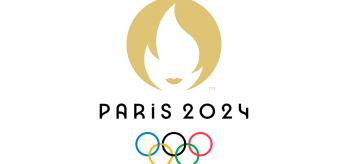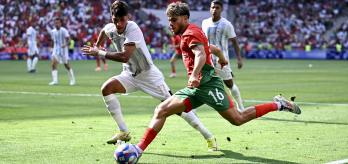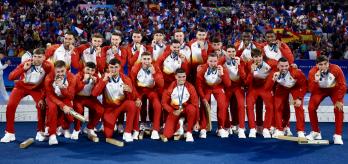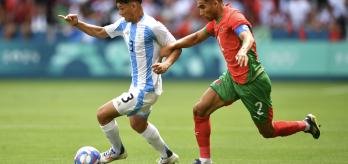As the men’s Olympic Football Tournament progresses through the knockout stages, the winning margins are becoming ever finer. FIFA’s Technical Study Group (TSG) and Football Performance Insights Team are on the ground in France, observing and analysing every match in the competition and presenting some of the intriguing technical and tactical ploys on show. In this article, TSG expert Anna Signeul highlights the impressive attacking gameplan that helped Spain secure a 3-0 victory over Japan in their quarter-final match. As she explained after the game:
“There was a clear strategy in how Spain were looking to build their play and break the first line of Japan’s aggressive high press. Once they broke this press, the speed of their forward passes and movements ahead of the ball to create and exploit space were outstanding. The technical excellence of the players as they interacted with the ball in these phases of play cannot be overstated.”
Breaking the first line of press
Spain had to work hard in their low build-up to break the first line of Japan’s aggressive press. They were comfortable on the ball under direct pressure, and used their centre-midfielders to great effect to create overloads, break defensive lines, and progress the play. This aspect of their play immediately caught Signeul’s expert eye:
“Japan pressed high, locking on to Spain’s centre-backs, full-backs and lowest midfielder, Pablo Barrios (6). As they did so, one of Spain’s other midfielders dropped in from a high position to become the spare player. Santi Denia’s side were very effective at doing this because all the players are so comfortable on the ball and were able to move it under pressure with one-touch passing. They had no real intention to circulate the ball; everything they do is designed to to break the lines. They wanted to break the press and expose the space left open on the opposite side of Japan’s press.”
Japan’s defensive set-up
Japan set up in a 1-4-4-2 shape when out of possession, a shape that, as the still photographs below show, sometimes looked more like a 1-3-1-4-2 when their left-sided centre-back, Seiji Kimura (5), dropped in to pick up one of Spain’s two attacking midfielders as their high press was engaged. Japan typically advanced from the 1-4-4-2 structure into a player-orientated press once the first player initiated the press. As highlighted in the graphic below, Japan’s players pushed on in the press 327 times against Spain, the highest figure for any game in the tournament so far.
Overloads in central midfield
When Japan engaged their press, Spain used their centre-midfielders to create the overloads that helped them to break the first line of their opponent’s press. When Spain’s attacking midfielder dropped in lower and offered to receive the ball, Japan’s centre-back Seiji Kimura was presented with a crucial dilemma: if he decided not to track the Spanish player, that player became a spare man, but if he did track him deep, he left a gap in Japan’s defensive line.
As we can see in the next set of graphics, these movements and offers to receive meant that Spain’s players were frequently able to receive the ball inside Japan’s team shape; they did so 75 times in this game (19 times more than in any other game in the tournament to date). In addition, the speed and accuracy of Spain’s passes helped them to create gaps in Japan’s defensive lines and to play through them – they completed no fewer than 48 line breaks through their opposition's shape in this match.
As Signeul points out, the individual skill of Spain’s players was key to this success:
“The technical ability of Spain’s players to move the ball quickly cannot be understated in this sequence of play. An open body shape when receiving the ball and passing to the correct foot so the receiver could play the next pass with one touch were also crucial factors. In addition, their ability to come in at speed to receive the ball in a closed shape, and the way they could use their body to protect from the incoming direct pressure and still be able to turn and play forward, is so impressive. The speed and weight of the passes in tight areas also really matters here, as does knowing when to pass to feet and when to play into space ahead of the receiving player. These are all signs of outstanding technical ability. Technically average players cannot play like that. As soon as they beat the press, they create powerful forward momentum by increasing the speed of their passing and forward runs, and it is very difficult to stop. For Spain, time is space."
In clip 1 below, we see a great of example of how Spain used their midfielders to progress their play. As Japan engage the high press, Fermín López (11) drops in deep to receive the ball, but is not tracked by Kimura . His presence alongside Barrios (6) creates an overload against Japan midfielder Joel Fujita (8), who presses Barrios when he receives the ball. The subsequent triangulation of fast, one-touch passes leads to Fermín López receiving the ball as the spare player. This is turn drags Japan’s central midfielder on the opposite side, Rihito Yamamoto (7), across, as Japan engage the man-to-man, player-orientated press. Fermín López turns and beats the press, opening into the large space in the middle and switching play to the other side of the pitch.
At this point, the third central midfielder, Alejandro Baena (10), is free in space to receive the ball and link play with the advancing forward line. Left-sided forward Sergio Gómez (17) is wide and making the forward run into space, while left-back Juan Miranda (3) is also advancing at speed to create an overload.
ROLE OF THE CENTRE-FORWARD
In addition to the movement in the centre of midfield, Spain’s centre-forward Abel Ruiz (9) also played an important role in Spain’s efforts to disrupt Japan’s defensive structure. Over the course of the game, he repeatedly created gaps in the defensive line and dropped in to offer to receive the ball, dragging defenders with him as they struggled to keep him under control. Spain were also extremely effective at getting runners into the spaces vacated by those defenders, and at getting the ball into those areas.
As Signeul explains, “Spain’s centre-forward was always offering to receive in behind and into feet. He used his body strength to hold defenders off and dictated the depth of Japan’s defensive line. When he dropped in, he created the space between his opponents’ midfield and defensive lines and linked other players into the play. He was an effective out-ball for his team, but also a decoy to drag defenders out of position and create space for other players to run in behind.”
The video clips below provide some examples of Ruiz’s movement and the way he offered to receive the ball. In clip 2, we see how he drops in to the space created by attacking midfielder Fermín López, who himself drops down to offer to receive. As soon as Ruiz receives the ball, he passes to Baena (10), who in turn plays into the space vacated by the defender who tracked the centre-forward.
Clip 3 is taken from the 90th minute of the game, and shows Spain’s consistency in their approach and attacking gameplan even after making substitutions. It also showcases all the components of Spain’s play outlined in this article so far: the central midfielders dropping in to create the overload to beat the first line of the press, the quick forward passes, the centre-forward movement to create space ahead of the ball, the switch of play to the opposite side of the pitch (via a spare midfielder), and the overlapping run from the left-back. When Spain combine all these elements effectively, they are a formidable attack force, as Anna Signeul observes:
“Spain’s players do not just make offers and movements to receive the ball. They follow up every action with another action, so even when they are 1v1 with opposition players, they eliminate them with this way that they play. As soon as they move the ball they advance, and therefore create overloads on the defenders ahead of them, who already have players to mark. It’s attacking football on a very high level.”
TRANSITIONS TO ATTACK
When transitioning to attack, Spain used the very same principles, progressing their play at speed and using their midfielders to create space and overloads in the centre of the pitch. When they lost the ball, Spain were aggressive in their press, and in transition they looked to play the first pass forward quickly to a player in space, outside the area covered by the Japanese counter-press.
To show exactly what this looked like in practice, Anna Signeul has selected another two video clips. As she explains, the speed of Spain’s attacking play was key:
“In clip 4, we see Spain regain possession following the interception of a forward pass, with right centre-back Eric García (4) stepping in with the ball before playing to centre-midfielder Baena (10), who is free in space away from Japan’s counter-pressing players. Even before Baena receives the ball, we can see how left-winger Gómez (17) is already making an attacking run into the space ahead of him and to the outside of Japan’s defensive line. As Baena receives the ball and drives forward centrally, Spain have support runners on both sides, including the powerful overlapping run (which is not tracked) from left-back Miranda (3). The speed of this forward play was the difference between the two teams.”
Finally, in clip 5, we see another speedy transition to attack, this time with left-back Miranda (5) advancing from deep to become the overloading player.
Summary
Spain’s technical skill and their ability to play fast, accurate passes to break the first line of their opposition’s press meant they could access space in other parts of the pitch. They used their three centre-midfielders to create numerical supremacy in both their build-up and progression phases. Once they broke the press, they advanced their play at electric speed, combining fast switches of play to the opposite side with constant movement and offers to receive to support the attacks. Their centre-forwards dictated the positioning of their opponent’s defensive line, dropping in to create receive between the lines and creating gaps to access space in behind. Finally, runners from deep created overloads also, as the attacks developed towards the final third making them very difficult to contain once they broke away.
In the end, Spain’s skill, movement and tactical nous proved too much for Japan’s defence to handle. La Roja’s convincing victory paved the way for a semi-final meeting with Morocco – a match in which Olympic medals will be at stake.





























